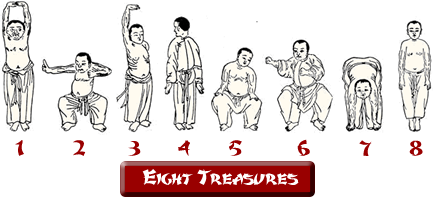The Baduanjin

The Ba Duan Jin 八段錦氣功 is translated most commonly as Eight Treasures, Eight Pieces of Brocade, Eight Section Brocade or Eight Silken Movements.
The name of the form generally refers to how the eight individual movements of the form characterize and impart a silken quality (like that of a piece of brocade) to the body and its energy.
The origin of the Eight Treasures (or Eight Section Brocade) is not certain. It is very old and might have originally been a Shaolin Buddhist martial arts warm up and stretching exercise set. However the routine was adopted as a Taoist set and today is practices as a Qigong (Ch'i Kung) form.
The physical and psychological benefits derived from using the Eight Treasures as a Qi Gong exercise routine can be obtained even if it is practiced solely as a martial arts warm up and stretching exercise set. You do not have to engage in the 'Chi guiding' aspect. (When the Eight Treasures movements are done at a faster pace or with more muscular emphasis, it is not always possible to concentrate on Yi guiding Chi anyway).
To gain full benefit from it you need 'perform' daily, moving precisely, but not to think a lot (if you don't channel Chi you have to 'empty your mind' - which I find almost impossible!). I have found that once the movements become familiar the idea of channelled spiritual energy movement also becomes second nature.
Most people will enjoy and benefit greatly from doing the Eight Section Brocade in a relaxed (Sung) manner. The use of intense muscular contractions, excessive stretching, or aggressive movements are counterproductive.
Pace, number of repeats and exertion
Instructors vary in the pace and level of difficulty they set for this form.
 Some instructors do the eight movements very slowly, very deliberately, repeating each movement only twice, and with a minimum of muscular effort. Some instructors do the eight movements very slowly, very deliberately, repeating each movement only twice, and with a minimum of muscular effort.
 Some teachers do the movements at a moderate pace, each movement to be done 8 to 16 times, with a degree of exertion that is moderate to demanding. Some teachers do the movements at a moderate pace, each movement to be done 8 to 16 times, with a degree of exertion that is moderate to demanding.
 Some encourage low horse stances, others use higher shoulder width stances. Some encourage low horse stances, others use higher shoulder width stances.
 Some are precise about repetitions, others not. Some are precise about repetitions, others not.
There can be slight to significant variations in the style and form of the movements depending upon the speed with which they are done, the order of the movements, and in the breathing patterns.
Standing or sitting?
It is usual to do the Eight Treasures in a Wu or active, standing style but there is also a Wen or slow, soft and seated style of the Ba Duan Jin.

|

![]()